Engerlings are larvae of various beetles. Some can cause great damage, others can be useful helpers in the garden.
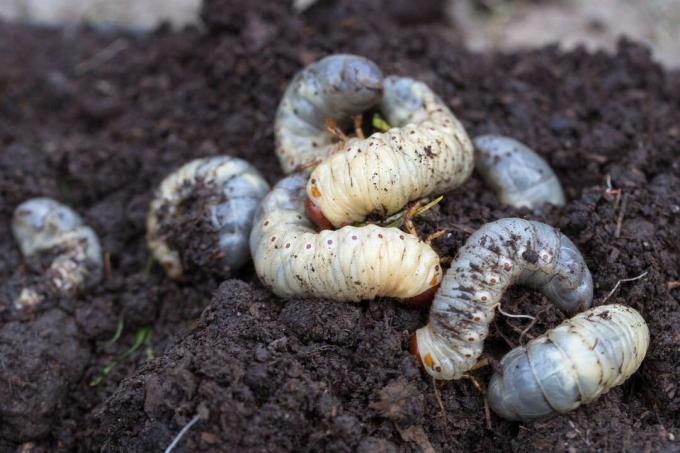
The larvae of the scarab beetle (Scarabaeoidea). The most common scarab beetle species are the May and May beetles June beetle (also ribbed tawny beetle), the garden beetles and the rose and rhinoceros beetles. While the adult beetles feed on leaf feeding (only minimal damage), the Grubs get their food under the ground and can cause great damage, for example by eating roots dish. But not all grubs are pests.
contents
-
Determine grubs and recognize differences
- Grubs: Recognizing Useful Species
- Grubs: Recognizing harmful species
-
Combat grubs: Get rid of harmful grubs
- grubs in flower pots and raised beds
- grubs in the lawn
Determine grubs and recognize differences
Below we have divided useful and harmful grubs and reveal how you can recognize the differences.
Grubs: Recognizing Useful Species
The larvae of the rose beetle and rhino beetle are considered beneficial. The Rhinoceros Beetle (
Oryctes nasicornis) is the largest representative of our native scarab beetle and is under nature protection. It can grow between 2.5 and 4 cm. Male rhinoceros beetles sport a backward-curved horn on their heads that closely resembles the horn of their heavyweight namesakes. The female animals only have a small elevation in the same place. The larvae have the typical shape of all scarab beetle larvae. They are very large, coarse and white in colour. On the forebody there are three relatively long pairs of legs and the brown head capsule. The entire body of the larva is curved in a C-shape.Also the rose chafer (Cetoniinae) is one of the protected beetle species. Its carapace has a shiny green to copper-gold color. Its underside is very hairy. It is often found on rose petals, hence its name. However, it is not really harmful to these plants.

The larvae of both the rose beetle and the rhinoceros beetle are very useful. They feed mainly on dead plant and wood residues and thus ensure the formation of humus. The females of both beetle species also like to lay their eggs in compost heaps.
To be able to recognize the "good" grubs, here are a few clear characteristics:
- the Rose chafer grub is white with greyish shading. Its front is a fair bit slimmer than the back. If you lay it on a flat surface, it will stretch, turn and crawl away on its back. He stretches three pairs of small legs at chest height.
- Also for the larva of rhino beetle three pairs of legs and a thickened posterior are typical. However, it towers twice as high as the larva of the rose chafer and can grow up to 10 cm long. The development of the grubs in the rose beetle takes two to three years. In the case of the rhinoceros beetle, it even lasts between two and five years. The different dates are influenced by the climate of the habitat of the animals.
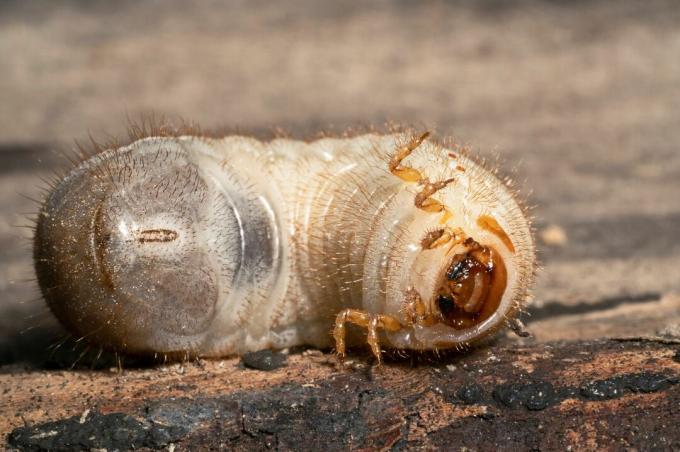
Both grub species feed on fallen or dead plant material or rotting wood and bark. So they do not damage living plants by eating roots like the grubs of the other scarab beetle species. Only when they are fully formed beetles do they feed on leaves. But even this almost never leads to defoliation.
Grubs: Recognizing harmful species
The larvae of May- (Melolontha), June- (Amphimallon solstitiale) and garden beetles (Phyllopertha horticola) are considered pests. They feed mainly on the roots of living plants.

The grubs of the three beetles mentioned above are not so easy to distinguish from one another. All have a C-curved body, a tan head capsule, and three pairs of legs on the thoracic region. However, they differ in size. The larva of the garden beetle is the smallest at just under 2 cm. That of the June beetle measures up to 3 cm and that of the May beetle can reach up to 6 cm. But be careful: Younger stages of the cockchafer larvae can easily be confused with those of the June beetle. If you want to be on the safe side, you have to get help from a professional when identifying. The front and rear parts of all three species are roughly the same diameter. Due to their crawling behavior, they can also be easily distinguished from the useful grubs of the rose and rhinoceros beetles. While these stretch and crawl away on their backs, the cockchafer larva keeps the crooked one posture, while June and garden beetles also stretch, but try to move forward in a prone position get.
Description of adult beetles:
the cockchafer:
Depending on the warmth of the living region, the May beetle grubs stay in the ground for three to five years. The beetle has brown wings, a black pronotum, and black and white markings reminiscent of triangles on the sides. Its feelers look like tiny fans.
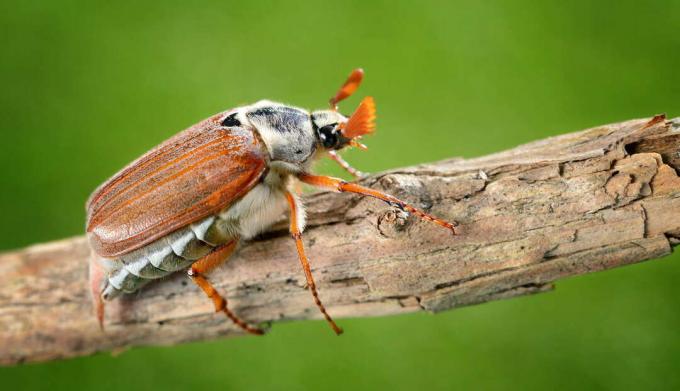
the June beetle:
The larvae of June beetle overwinter twice and pupate in the spring of the third year. The beetles also have fan-like antennae. The color of their carapace ranges from brown to dark yellow. The pronotum stands out the darkest and is divided by a light central line.
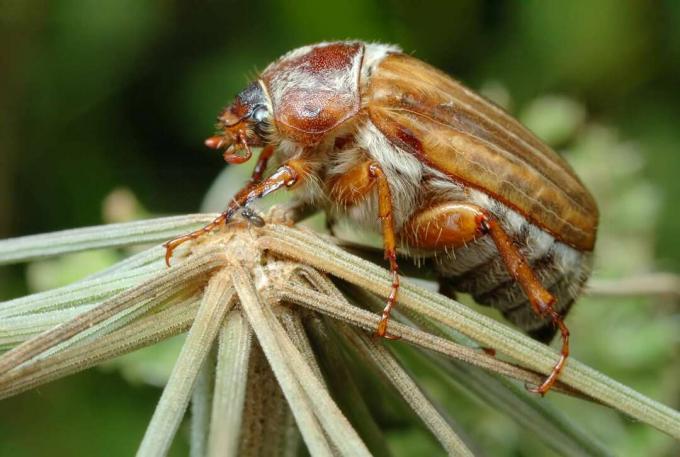
the garden beetle:
The life cycle of the garden beetle from laying eggs to the finished beetle is between one and three years, depending on the climate. They grow about 1 cm long. Their elytra are light brown in color. The rest of the body is black-green with a metallic sheen.
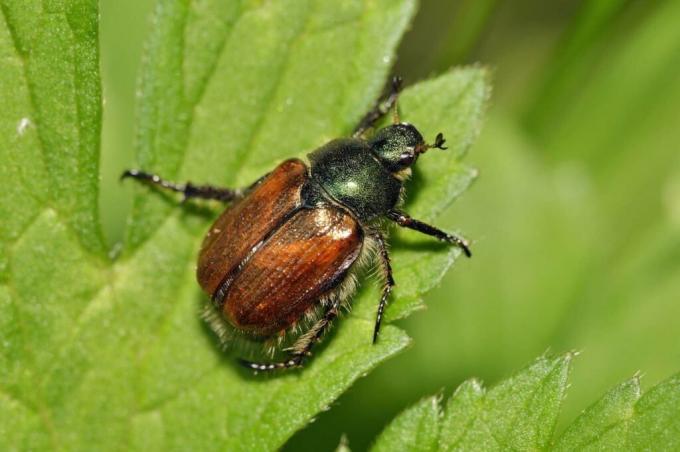
The grubs of the May, June and garden chafers commit the greatest root damage on lawns and in tub and potted plants.
Combat grubs: Get rid of harmful grubs
The larvae of May, June and garden beetles can be found in many gardens, often without being noticed. If there are only a few pests, then the root damage is not a threat to the plants and they can regenerate well. However, if a large number of grubs are present, then one should think about controlling the pests to protect the plant.
grubs in flower pots and raised beds
If a plant in the pot is ailing and you want to find out if grubs are the cause, completely submerge the pot in a bucket of water. Wait an hour or two. The little animals don't like total wet at all and soon appear on the surface. Now you can collect the pests.
If you want to be on the safe side, you should water the plants with water containing nematodes of the genus Heterorhabditis bacteriophora, like ours Plantura HB nematodes, is mixed. These represent the most effective method of fighting grubs. The tiny roundworms attach themselves to the grubs of June beetles, garden leaf beetles and somersault beetles, parasitize them and kill them. The same applies here: the environmental conditions determine the success or failure of the use of nematodes.
More useful tips and facts about using Nematodes as beneficial insects see this article.
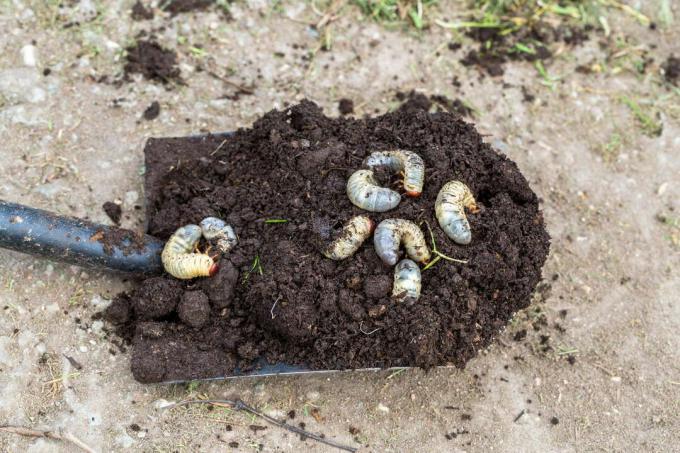
Basically, you should never put flower pots in the garden without saucers. It also helps to plant a geranium scion in addition to the potted plants. The grubs don't like geraniums at all. They also avoid delphiniums.
In the case of raised beds, it would still be advisable to pour the soil through a sieve before sowing or replanting. Then you have a certain certainty that there are no grubs in the ground.
Last but not least, one must not forget that there are a few grubs living in every beautiful garden. In limited numbers, they also do no significant damage.
grubs in the lawn
If you discover bald spots in your lawn, grubs could be the reason. They eat the roots of the grass, causing it to wither. The turf of the bird's nest-sized squares can be easily pulled off. Just below the surface are the larvae of one or more of the beetles named above. If then also crows, blackbirds or other birds scour the bald spot for protein-rich prey, the damage will be all the greater.
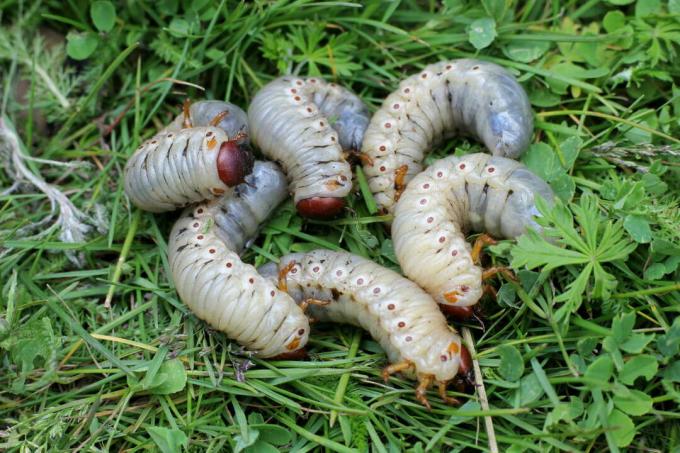
Just like fighting grubs in flower pots or raised beds, you can do well here HB nematodes, so-called roundworms of the genus heterorhabditis bacteriophora, come into use. Optimal conditions are a key success factor. Make sure that your little helpers are used at a temperature of at least 12 °C so that you can fight the grubs effectively. The correct application period for Engerlingen is between July and September.
Grub traps direct the animals to other places in the garden. For this you need large planters or buckets of water. These are filled up to 10 cm with compost or horse manure. These vessels are buried about half a meter deep in the garden and the edge left free is filled with soil. It is best to dig the grub traps into the ground near the infested lawns in the spring months. Only after a year are they removed, refilled and buried again. Tip: Allow plenty of dandelions to grow all around.
If you can limit the grubs to one spot in the garden, you have created a paradise for them, so to speak, then deep vertical slabs (e.g. rhyzome barriers) can be embedded in the ground to further protect this area to contain If you want to prevent an infestation of the lawn, spread garlic tea over the entire lawn. The grubs are deterred by this.

Tip: Many gardeners think that frequent lawn mowing can minimize grub numbers. However, mowing the lawn too often or even scarifying it even makes it easier for the grubs to enter the ground. Therefore, ensure a dense, closed lawn and let the lawn grow a little longer. The visual disadvantage turns out to be a great advantage for pest control and can reduce infestation by grubs by up to 70%.
For more tips on Control of grubs in the lawn you can find further information here.



